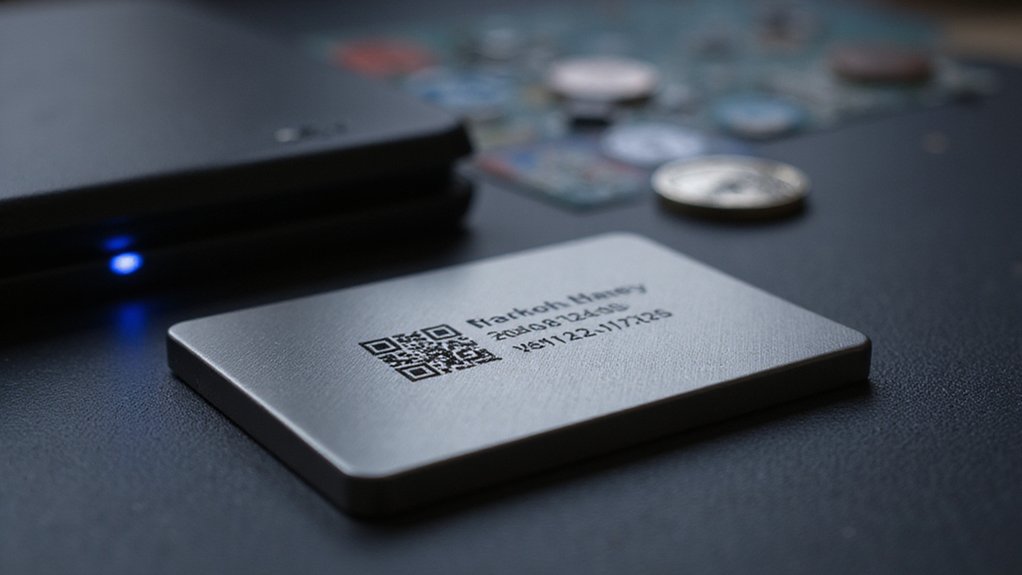A private key in cryptocurrency serves as your digital vault combination—a 256-bit number represented as a 64-character hexadecimal string that authorizes blockchain transactions. Unlike traditional banking, this cryptographic signature mechanism verifies asset movement without revealing your identity, embodying the principle that possession equals ownership. Hardware wallets and cold storage options offer protection against hacking, but improper key management has consigned billions to digital limbo. The sobering reality? Lose this mathematical cornerstone and your crypto vanishes irretrievably into the blockchain ether.

The private key, that most enigmatic yet essential component of cryptocurrency infrastructure, operates as the digital equivalent of both a vault combination and an autograph—simultaneously protecting assets and authorizing their movement across the blockchain.
This alphanumeric sequence, typically a 256-bit number rendered as a 64-character hexadecimal string, serves as the mathematical cornerstone of cryptocurrency ownership in a system where possession truly equals nine-tenths of the law (if not all ten).
In cryptocurrency’s realm, ownership hinges on an inscrutable string of characters—the mathematical equivalent of divine right.
Unlike traditional financial systems where forgotten passwords can be reset through customer service—that quaint relic of centralized finance—the irreversible nature of private key management means the common refrain “not your keys, not your crypto” isn’t merely cautionary but existential.
The cryptographic relationship between private and public keys exemplifies elegant mathematical asymmetry: while public keys derive from private keys through complex algorithms, the reverse calculation remains computationally infeasible, even for quantum computers lurking on the horizon.
The private key’s functionality extends beyond mere asset protection, enabling the cryptographic signing process that verifies transaction authenticity without revealing the key itself—a technological sleight of hand that underpins the trustless, peer-to-peer nature of blockchain networks.
This signature mechanism, rather like an invisible yet unforgeable pen, authorizes the movement of digital assets while maintaining the pseudonymous character of blockchain transactions. In decentralized cryptocurrency systems, users can maintain transaction anonymity without revealing personal identification information that traditional banking requires.
Storage options for these critical strings range from sophisticated hardware wallets (those peculiar USB-like devices favored by the paranoid and prescient alike) to the deceptively analog “cold storage” methods involving paper, metal, or even memorization for the mnemonically gifted.¹ Hardware wallets provide superior security by keeping private keys in offline storage, completely isolated from internet-connected devices that are vulnerable to hacking attempts.
The consequences of improper storage—whether through digital theft or simple human forgetfulness—have resulted in billions worth of cryptocurrency suspended in a peculiar limbo: mathematically accessible yet practically unreachable.
The private key therefore remains cryptocurrency’s double-edged sword: offering unprecedented autonomy while demanding equally unprecedented responsibility, in a financial ecosystem where “forgetting your password” might constitute an irrevocable donation to digital scarcity.
If a private key is compromised, the thief gains complete control over assets and can immediately transfer all funds to their own wallet with no possibility of transaction reversal.
¹Though memorization, one might note, remains vulnerable to that most analog of threats—mortality.
Frequently Asked Questions
How Do I Securely Back up My Private Keys?
Secure private key backups require a multi-layered approach: hardware wallets like Trezor or Ledger provide superior security, while encrypted USB drives offer convenient alternatives.
One should maintain multiple copies stored in geographically diverse locations (ideally fireproof and waterproof), regularly verify backup integrity, and—this seems obvious yet remains curiously overlooked—never store backups on internet-connected devices.
Combining physical security with cryptographic safeguards creates the necessary resilience against both mundane loss and sophisticated threats.
Can Private Keys Be Recovered if Forgotten or Lost?
Recovering forgotten private keys presents crypto investors with a sobering reality check: without proper backups, permanent asset loss is virtually inevitable.
While seed phrases (those vital 12-24 word sequences) offer salvation when properly preserved, the blockchain’s immutable architecture makes actual key recovery impossible without them.
Professional recovery services exist, though their efficacy remains questionable at best.
This unforgiving aspect of cryptocurrency—where a single moment of carelessness can vaporize millions—underscores why paranoid-level backup strategies aren’t merely prudent, but essential.
What Happens to Crypto if the Private Key Holder Dies?
When cryptocurrency owners meet their demise without sharing private keys, their digital assets effectively become stranded in the blockchain—a particularly modern form of financial purgatory.
Without established inheritance protocols, these virtual fortunes remain inaccessible, highlighting the critical importance of posthumous planning.
Some forward-thinking investors utilize dead man’s switches, multisignature wallets, or trusted custodians, while others incorporate crypto assets into traditional estate planning through secure instructions for key retrieval after their inevitable corporeal exit.
Are Hardware Wallets Worth the Investment for Storing Keys?
Hardware wallets represent a prudent investment for cryptocurrency holders with significant assets.
The offline storage of private keys (the veritable “keys to the kingdom”) substantially mitigates exposure to online threats—a non-trivial consideration in an ecosystem where hacks remain distressingly common.
For a relatively modest investment of $50-200, these devices offer substantial security advantages over software alternatives, particularly through their use of secure element chips and mandatory physical transaction verification.
The cost-benefit calculus becomes increasingly favorable as portfolio value increases.
Can Quantum Computing Break Current Private Key Encryption?
Quantum computing presents a legitimate existential threat to current cryptocurrency encryption standards.
Through Shor’s algorithm, quantum systems could theoretically break the asymmetric cryptography (RSA and ECC) underpinning private keys.
Chinese researchers have already demonstrated promising—though limited—results using D-Wave systems.
While industrial-scale quantum computers capable of breaking 256-bit encryption remain developmental, the crypto community isn’t waiting for doomsday; post-quantum cryptographic solutions (lattice-based, code-based, and hash-based approaches) are actively being developed as countermeasures to this looming threat.









